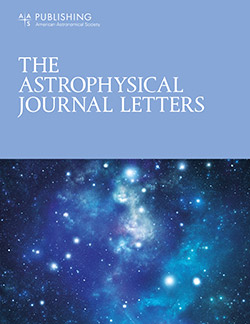非球面II型超新星SN 2023ixf的早期光谱偏振测量
IF 8.8
1区 物理与天体物理
Q1 ASTRONOMY & ASTROPHYSICS
引用次数: 2
摘要
摘要:我们研究了II型超新星(SN) 2023ixf在爆炸后2 ~ 15天内的6个光谱偏振谱。偏振测量是由利克天文台Shane 3米望远镜上的Kast双摄谱仪获得的,这是迄今为止对超新星进行的最早的观测。我们观察到,在+1.4和+2.5天,连续极化p = 1%,在+3.5天降至0.5%,并持续到+14.5天。值得注意的是,这种变化与高度电离的“闪光”特征的消失在时间上是一致的。连续介质极化的减小伴随着偏振位角(PA)的旋转~ 70°,在整个连续介质上可见。极化的早期演化可能表明,在与高电离物质(如He ii, C iv和N iii)相关的发射线消失前后,电子散射大气的几何构型不同,这可能是在SN爆炸前不久由于质量损失增加而产生的。我们认为从+2.5天到+4.5天的极化和PA的快速变化是SN喷射从致密的不对称星周物质(CSM)中出现的时间。连续极化和PA的时间演化与非球面SN爆炸相一致,与CSM相比具有明显的几何特征。SN 2023ixf在激波电离阶段的快速跟踪光谱偏振测量揭示了导致爆炸的异常不对称的质量损失过程。本文章由计算机程序翻译,如有差异,请以英文原文为准。
Early Time Spectropolarimetry of the Aspherical Type II Supernova SN 2023ixf
Abstract We present six epochs of optical spectropolarimetry of the Type II supernova (SN) 2023ixf ranging from ∼2 to 15 days after the explosion. Polarimetry was obtained with the Kast double spectrograph on the Shane 3 m telescope at Lick Observatory, representing the earliest such observations ever captured for an SN. We observe a high continuum polarization p cont ≈ 1% on days +1.4 and +2.5 before dropping to 0.5% on day +3.5, persisting at that level up to day +14.5. Remarkably, this change coincides temporally with the disappearance of highly ionized “flash” features. The decrease of the continuum polarization is accompanied by a ∼70° rotation of the polarization position angle (PA) as seen across the continuum. The early evolution of the polarization may indicate different geometric configurations of the electron-scattering atmosphere as seen before and after the disappearance of the emission lines associated with highly ionized species (e.g., He ii , C iv , and N iii ), which are likely produced by elevated mass loss shortly prior to the SN explosion. We interpret the rapid change of polarization and PA from days +2.5 to +4.5 as the time when the SN ejecta emerge from the dense asymmetric circumstellar material (CSM). The temporal evolution of the continuum polarization and the PA is consistent with an aspherical SN explosion that exhibits a distinct geometry compared to the CSM. The rapid follow-up spectropolarimetry of SN 2023ixf during the shock ionization phase reveals an exceptionally asymmetric mass-loss process leading up to the explosion.
求助全文
通过发布文献求助,成功后即可免费获取论文全文。
去求助
来源期刊

Astrophysical Journal Letters
ASTRONOMY & ASTROPHYSICS-
CiteScore
14.10
自引率
6.30%
发文量
513
审稿时长
2-3 weeks
期刊介绍:
The Astrophysical Journal Letters (ApJL) is widely regarded as the foremost journal for swiftly disseminating groundbreaking astronomical research. It focuses on concise reports that highlight pivotal advancements in the field of astrophysics. By prioritizing timeliness and the generation of immediate interest among researchers, ApJL showcases articles featuring novel discoveries and critical findings that have a profound effect on the scientific community. Moreover, ApJL ensures that published articles are comprehensive in their scope, presenting context that can be readily comprehensible to scientists who may not possess expertise in the specific disciplines covered.
 求助内容:
求助内容: 应助结果提醒方式:
应助结果提醒方式:


